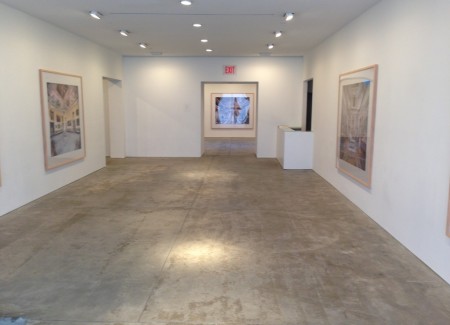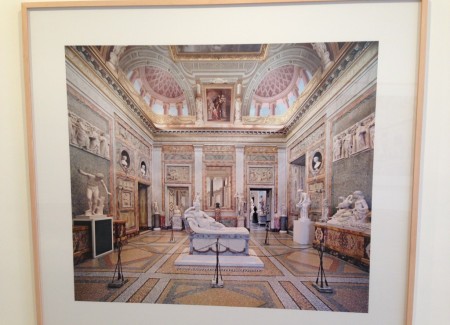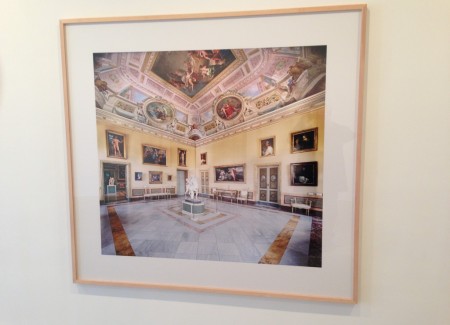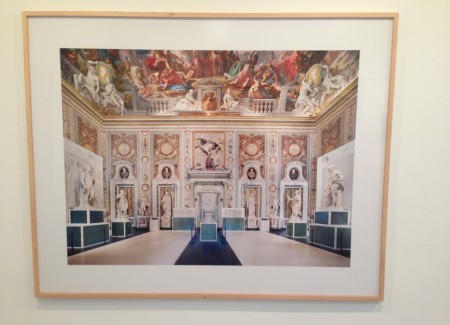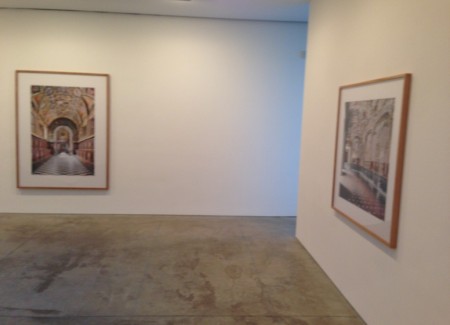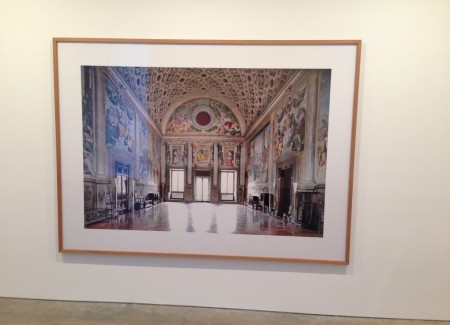JTF (just the facts): A total of 11 large format color photographs, framed in blond wood and unmatted, and hung against white walls in a series of three rooms. All of the works are c-prints, made between 2008 and 2013. Most of the prints are roughly 72 inches high and at least 74 inches wide, in editions of 6+2AP. The new works here depict interiors of the Villa Borghese in Rome and were made in 2012-2013. Filling out the show are four photographs of other Italian interiors, from the Biblioteca Ricciardini in Florence to the church of San Martino in Naples, that were made in 2008-2009. (Installation shots below.)
Comments/Context: Candida Höfer has reached that stage of her career where she is welcome to bring her large-format camera into almost any cultural institution. Her reputation is such that it can’t be much of a struggle anymore to gain access, especially as all parties benefit. Directors or trustees of august museums, libraries or churches (usually in Europe) know that in exchange for allowing her plenty of time to work, she will glorify their mission and their architecture. What’s more, her color photographs are discreetly sumptuous, neither too grandiose nor too nosy, I have seldom seen a Hofer photograph in recent years of a place that I didn’t want one day to visit or that made it look shabbier than I had imagined.
In 2012-2013, she was given the run of the Villa Borghese in Rome. This Baroque building, erected in the 17th century to house the collection of Cardinal Scipione Borghese in what became the Galleria Borghese, may contain more Renaissance and Baroque masterpieces – paintings by Raphael, Caravaggio, Titian, Rubens, Bellini, Dosso Dossi, Antonella da Messina, Correggio, Barocci, and sculptures by Bernini and Canova – than any museum of its size (only twenty galleries on two floors) in the world. Höfer was invited to photograph a special installation, when many of the 344 pieces that had been sold in the early 19th century (under financial pressure) to Napoleon I, were returned from the Louvre.
Faced with so many esteemed artistic competitors on every wall, Höfer has pushed back with the tools of a big-camera photographer. Her focus is not on individual works of art but on the bigger picture of the voluminous rooms they inhabit. As in her photographs of libraries, with their emphasis on shelves of books and rows of study carrels, it’s the patterning and ordering of space that interests her.
Because the Galleria Borghese dates to the early Baroque, when entire rooms were conceived as integrated works of art for wealthy patrons, every angle where Höfer might have chosen to stand yielded dazzling geometry for the eye. There are no neutral spaces or dead zones. As in the finest Roman interior design from this period, there are no clear demarcations between the planes of floors, walls, and ceilings. As an ensemble they have a writhing muscularity even when Höfer’s long exposures have bathed them in calm, milky natural light.
In a couple of examples (numbers II and XIV) she has pulled her camera back into a corner, aimed across the room at the corner opposite, and tilted the lens so that muraled ceiling and marble floor occupy equal portions of space. Moldings along the top of the walls converge to make the photographs into a diamond-like prism. Looking at these faceted planes, painted in pale yellows, blues, grays, and ochres, can be like standing in front of an enormous kaleidoscope.
Even when the angle she takes is frontal, the results are not static. All of these rooms are boastful displays of trompe l’oeil architectural effects: illusory squinches with colonnettes and coffered domes (number XIII). Sometimes Höfer has warped the space with her camera (number III); more often an Italian designer did that work for her centuries ago.
Studious refinement is now a trademark of hers, and a problem. Earlier in her career, during the 1970s, when she preferred small- or medium-format, her subjects were fugitive and sometimes even included people. Large-format by its nature tends to be more passive but has led to a mannered predictability in her case. I wish she would take her camera to untidier spots that weren’t already historically validated. She risks becoming known as the official photographer of World Heritage Sites.
Needless to say, viewing photographs of Baroque interiors, crammed edge-to-edge with color, on the walls of a white box art gallery like Sonnabend, is a shocking contrast. As always with Höfer of late, whatever space her camera is privy to seems more gracious than wherever you happen to be.
Collector’s POV: The works in this show are priced as follows. Nearly all of the prints are priced at €52000 each, with the exception of the largest print (number IV) at €58000 (unframed). Höfer’s work is widely available in the secondary markets. Smaller pieces can be found well under $10000 (often in editions of up to 100), while the larger works (printed in much smaller editions, usually 6) have ranged between $15000 and $105000.

